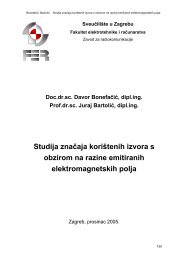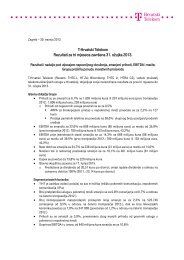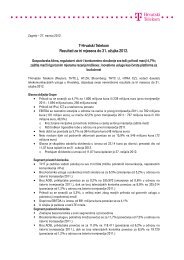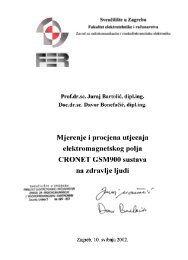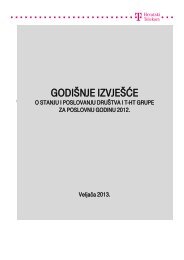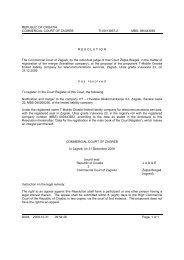Annual Report 2011 - T-Hrvatski Telekom
Annual Report 2011 - T-Hrvatski Telekom
Annual Report 2011 - T-Hrvatski Telekom
You also want an ePaper? Increase the reach of your titles
YUMPU automatically turns print PDFs into web optimized ePapers that Google loves.
85<br />
Impairment losses relating to goodwill cannot be<br />
reversed in future periods. The Group performs<br />
its annual impairment test of goodwill as at 31<br />
December. Please see Note 10 for more details.<br />
f) Property, plant and equipment<br />
An item of property, plant and equipment that<br />
qualifies for recognition as an asset is measured at<br />
its cost. The cost of an item of property, plant and<br />
equipment comprises its purchase price, including<br />
import duties and non-refundable purchase taxes,<br />
after deducting trade discounts and rebates, and any<br />
directly attributable costs of bringing the asset to its<br />
working condition and location for its intended use.<br />
In addition to directly attributable costs, the costs of<br />
internally constructed assets include proportionate<br />
indirect material and labour costs, as well as<br />
administrative expenses relating to production or the<br />
provision of services.<br />
After recognition as an asset, an item of property,<br />
plant and equipment is measured at cost less<br />
accumulated depreciation and any accumulated<br />
impairment losses.<br />
Each part of an item of property, plant and equipment<br />
with a cost that is significant in relation to the total<br />
cost of the item is depreciated separately.<br />
Depreciation is computed on a straight-line basis.<br />
Useful lives of newly acquired assets are as follows:<br />
Buildings<br />
Telecom plant and machinery<br />
Cables<br />
Cable ducts and tubes<br />
Other<br />
Tools, vehicles, IT, office and other<br />
equipment<br />
Land and assets under construction are not<br />
depreciated.<br />
10 — 50 years<br />
8 — 18 years<br />
30 years<br />
2 — 15 years<br />
4 — 15 years<br />
The useful life, depreciation method and residual<br />
values are reviewed at each financial year-end,<br />
and if expectations differ from previous estimates,<br />
the change(s) are accounted for as a change in an<br />
accounting estimate.<br />
Construction-in-progress represents plant and<br />
properties under construction and is stated at cost.<br />
Depreciation of an asset begins when it is available<br />
for use.<br />
g) Impairment of assets<br />
Impairment of non-financial assets<br />
The determination of impairment of assets involves<br />
the use of estimates that include, but are not limited<br />
to, the cause, timing and amount of the impairment.<br />
Impairment is based on the large number of<br />
factors, such as changes in current competitive<br />
conditions, expectations of growth in the industry,<br />
increased cost of capital, changes in the future<br />
availability of financing, technological obsolescence,<br />
discontinuance of services, current replacement<br />
costs, prices paid in comparable transactions and<br />
other changes in circumstances that indicate an<br />
impairment exists. The recoverable amount and<br />
the fair values are typically determined using the<br />
discounted cash flow method which incorporates<br />
reasonable market participant assumptions. The<br />
identification of impairment indicators, as well as the<br />
estimation of future cash flows and the determination<br />
of fair values for assets (or groups of assets) require<br />
management to make significant judgments<br />
concerning the identification and validation of<br />
impairment indicators, expected cash flows,<br />
applicable discount rates, useful lives and residual<br />
values. Specifically, the estimation of cash flows<br />
underlying the fair values of the business considers<br />
the continued investment in network infrastructure<br />
required to generate future revenue growth through<br />
the offering of new data products and services, for<br />
which only limited historical information on customer<br />
demand is available. If the demand for those products<br />
and services does not materialize as expected, this<br />
would result in less revenue, less cash flow and<br />
potential impairment to write down these investments<br />
to their fair values, which could adversely affect future<br />
operating results.<br />
Consolidated financial statements



